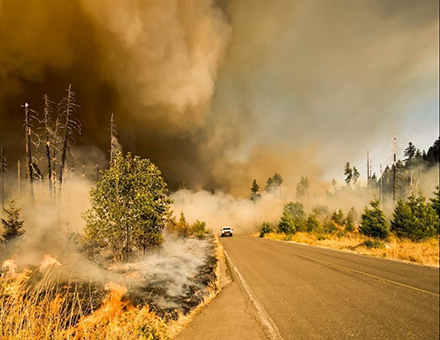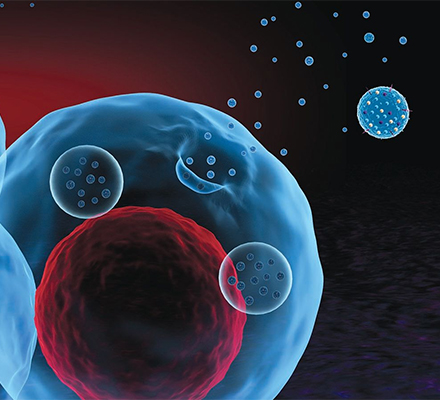By Lauren Sprouse

Climate change is fueling longer wildfire seasons , leading to more frequent and intense fires that could have disastrous consequences for human health.
Wildfire smoke - a potent concoction of particulate matter, carbon dioxide, hydrocarbons, and other chemicals - can cause short- and long-term health effects , ranging from throat irritation and headaches to an increased risk of heart attack, asthma exacerbation, and reduced lung function.
Despite known associations between wildfire smoke exposure and heart and lung diseases, the biological mechanism behind these effects has not been fully established. In a recent study , funded in part by NIEHS, researchers explored the cardiopulmonary, or heart and lung, responses to wildfire smoke.
"The better we understand the biological responses to wildfire smoke, the more we can do to reduce exposures and improve health," said Julia Rager, Ph.D., a professor of environmental sciences and engineering at the University of North Carolina at Chapel Hill and principal investigator of the study. "Through this research, we wanted to understand what chemicals drive toxicity, the underlying mechanisms behind health impacts, and the wildfire conditions that can be recreated for health risk assessments."
Cell Messengers Mediate Wildfire Smoke Responses

Rager and team studied how wildfire smoke interfered with communication between cells. Specifically, they focused on extracellular vesicles, which are tiny messengers that carry information from one cell to another. That information can include molecules called microRNAs, which regulate gene expression.
"We wanted to determine whether various wildfire smoke exposures impacted microRNAs found within extracellular vesicles," Rager explained. "Changes in microRNA expression may indicate cell stress signaling in the lung and heart."
The researchers simulated wildfire exposure scenarios in the lab by burning two types of organic matter - peat and red oak - at either a flaming or smoldering burn. After collecting the smoke in special tubes, they applied a process that allowed them to analyze its constituents. Next, they exposed mice to the contaminants, assessing the effects on extracellular vesicles and microRNAs in the heart, lungs, and blood plasma.
"A major limitation to wildfire research is that it is difficult to evaluate the effects in humans," Rager said. "We have to leverage other models, like mice studies, to capture the highly variable landscape of potential wildfire exposures."
Health Implications Inform Interventions
The team found that smoke exposures caused significant changes in markers of tissue injury and inflammation in the heart and lungs, with the greatest changes associated with flaming conditions. Compared to smoldering burns, flaming conditions likely produce more toxic compounds - including polycyclic aromatic hydrocarbons - that may increase the risk of health effects from smoke exposure, according to the researchers.
In lung tissue, changes in microRNA expression were linked to cell stress and hypoxia, or a lack of oxygen. The authors suggested that these stress responses may subsequently trigger the release of extracellular vesicles from the injured tissue into circulating blood and eventually into the heart, leading to damage there as well.
"This was the first study to evaluate the potential role of extracellular vesicles in mediating cross-tissue communication in response to wildfire smoke," said Rager. "We found that wildfire smoke induced changes in microRNA expression within blood plasma extracellular vesicles, which highlights the role of circulating extracellular vesicles as a potential mechanism through which wildfire smoke can lead to cardiopulmonary responses."
According to Rager, understanding which geographic regions and populations are at the highest risk of wildfires is the first step in designing public health interventions to reduce the risk of health effects.
"Lower-income populations and individuals with less access to transportation may be unable to safely evacuate as quickly as others in the event of a wildfire," Rager said. "If their property or homes were damaged, they may not have the resources to rebuild."
Rager and team are now investigating wildfires in urban environments to understand and mitigate the health effects associated with burning human-made materials, like plastics, plywood, and tires.
Wildfire Focus at NIEHS
NIEHS supports research efforts on the health effects of climate change. As wildfires continue to increase in frequency and intensity, this research may help communities understand, adapt to, and mitigate the problems associated with smoke exposure:
- Small business grantees are working to develop biosensors for personal wildfire exposure monitoring and create ozone monitors for communities affected by wildfires.
- Individual research grantees study the impacts of wildfires on infant health, cardiopulmonary health, and Alzheimer's disease.
- Exploratory research grantees investigate the impacts of wildfire smoke on psychosocial stress and developmental health, the immune system, and the microbiome - the collection of microorganisms in the body.
Environmental Health Perspectives, a peer-reviewed open-access journal published with NIEHS support, created a Wildfire Smoke Collection that presents original research and research reviews that explore human exposure, health risks, and impacts of wildfires.
The NIEHS Worker Training Program supports wildfire response operations in the U.S. and creates training tools for workers assigned to disaster sites. NIEHS also developed a protocol for assessing cancer risks related to wood smoke exposure.
Citation:
Carberry CK, Koval LE, Payton A, Hartwell H, Ho Kim Y, Smith GJ, Reif DM, Jaspers I, Ian Gilmour M, Rager JE. 2022. Wildfires and extracellular vesicles: exosomal microRNAs as mediators of cross-tissue cardiopulmonary responses to biomass smoke. Environ Int 167:107419. [ Full Text ]


